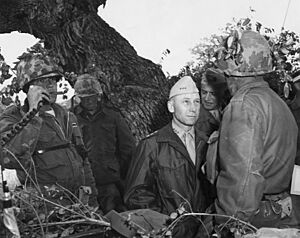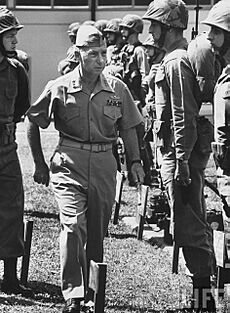Victor H. Krulak facts for kids
Quick facts for kids
Victor H. Krulak
|
|
|---|---|
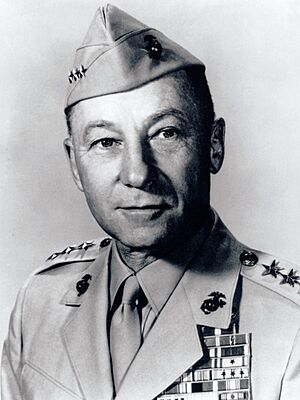 |
|
| Nickname(s) | "Brute" |
| Born | January 7, 1913 Denver, Colorado, U.S. |
| Died | December 29, 2008 (aged 95) San Diego, California, U.S. |
| Buried |
Fort Rosecrans National Cemetery, San Diego
|
| Allegiance | United States |
| Service/ |
United States Marine Corps |
| Years of service | 1934–1968 |
| Rank | Lieutenant general |
| Service number | 0-4990 |
| Commands held | Fleet Marine Force, Pacific Marine Corps Recruit Depot San Diego 5th Marine Regiment 2nd Parachute Battalion |
| Battles/wars |
|
| Awards | Navy Cross Navy Distinguished Service Medal Legion of Merit (3) Bronze Star Medal (with "V") Purple Heart Air Medal |
| Spouse(s) | Amy Chandler (1936–2004; her death; 3 children) |
| Relations | General Charles C. Krulak (son) |
| Other work | Newspaper columnist |
Victor Harold Krulak (January 7, 1913 – December 29, 2008) was a highly respected officer in the United States Marine Corps. He was known for his bravery and leadership in three major wars: World War II, the Korean War, and the Vietnam War.
Many Marines saw Krulak as a forward-thinking leader. He wrote a famous book called First to Fight: An Inside View of the U.S. Marine Corps. His son, General Charles C. Krulak, later became the 31st leader of the Marine Corps.
Contents
Early Life and Military Start
Victor Krulak was born in Denver, Colorado. He married Amy Chandler in 1936, and they had three children. Amy passed away in 2004.
Krulak joined the Marine Corps after graduating from the United States Naval Academy in 1934. He was a bit shorter than the usual height requirement, but he got a special permission to join. While at the Naval Academy, he was a strong wrestler, which earned him the nickname "Brute."
Early Marine Corps Missions
In his early career, Krulak served on the battleship USS Arizona (BB-39). He also worked at the Naval Academy and with Marine units in San Diego and China.
While in Shanghai, China, in 1937, Krulak noticed a special Japanese landing boat. It had a ramp at the front that could be lowered. He thought this design would be very useful for the U.S. military. Krulak sent pictures and details back home. Years later, his ideas helped a boat builder named Andrew Higgins create the "Higgins boat." This boat was very important for landing troops on beaches during World War II, including the famous Normandy Landings.
Serving in World War II
When World War II began, Krulak was a captain. He volunteered for parachute training and then led the 2nd Parachute Battalion in the Pacific. He fought alongside New Zealand troops at Vella Lavella.
Heroism at Choiseul Island
In 1943, as a lieutenant colonel, Krulak showed great bravery on Choiseul Island. His battalion carried out a week-long raid to distract enemy forces. This allowed the main U.S. attack on Bougainville to happen more easily. Even though he was wounded, Krulak kept leading his troops. For his actions, he received the Navy Cross and the Purple Heart.
The Navy Cross is given to Victor H. Krulak, a Lieutenant Colonel in the U.S. Marine Corps. He showed amazing bravery as the leader of the Second Battalion, First Marine Parachute Regiment, during battles on Choiseul Island, Solomon Islands, from October 28 to November 3, 1943. His mission was to draw the enemy's attention away from our main attack force heading to Empress Augusta Bay, Bougainville Island. Lieutenant Colonel Krulak landed at Choiseul and bravely led his battalion against the Japanese. They destroyed tons of supplies and burned enemy camps and landing barges. Even though he was hurt during the attack on October 30, he refused to give up his command. With fearless courage and strong dedication, he continued to lead his battalion against a larger Japanese force. His brilliant leadership and strong fighting spirit made this important mission a success. These actions were in line with the highest traditions of the United States Naval Service.
A navy PT boat called PT-59, led by John F. Kennedy, helped evacuate Krulak's troops from Choiseul. Krulak later gave Kennedy a bottle of whiskey, nearly 20 years later, when Kennedy was President.
After the war, Krulak returned to the U.S. and held various leadership roles. He commanded the 5th Marine Regiment at Camp Pendleton.
Korean War Service
When the Korean War started, Krulak was a chief of staff for the 1st Marine Division in Korea. He earned another Legion of Merit medal for his service there.
Vietnam War Leadership
From 1962 to 1964, Krulak worked with the Joint Chiefs of Staff on fighting against rebel groups. He received another Legion of Merit for his excellent service. During this time, American advisors were helping South Vietnam fight against the Viet Cong.
In September 1963, Krulak and another official, Joseph Mendenhall, went on a mission to learn about the war's progress. Krulak believed the situation was good, but Mendenhall disagreed. This led President Kennedy to famously ask if they had visited the same country.
In March 1964, Krulak became the Commanding General of the Fleet Marine Force, Pacific. He was promoted to lieutenant general. For the next four years, he was in charge of all Marine units in the Pacific. He traveled to Vietnam about 54 times. The Chu Lai base, started in 1965, was named after Krulak's Chinese name.
War Strategy Ideas
At the start of the Vietnam War, Krulak suggested the "Spreading Inkblot Theory." This idea was to use small Marine units to make South Vietnam peaceful, village by village. If large enemy groups were found, then General Westmoreland's powerful forces would be used. Krulak also wanted to bomb North Vietnam heavily and mine Haiphong Harbor.
However, Krulak's plans were not fully used. General Westmoreland preferred to defeat the enemy with strong firepower. The U.S. government also worried that heavy bombing of North Vietnam might cause the Soviets and Chinese to get involved. Krulak also did not agree with setting up the Khe Sanh Combat Base.
Krulak hoped to become the next leader of the Marine Corps. But in 1967, President Lyndon B. Johnson chose Leonard F. Chapman, Jr. instead. Krulak retired on June 1, 1968, and received the Navy Distinguished Service Medal for his service. Some say his honest comments to President Johnson about the war led to this decision. Later, his son, Charles C. Krulak, did become the 31st Commandant of the Marine Corps.
Awards and Decorations
Krulak received many awards for his bravery and service. These include:
 |
|||
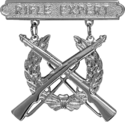 |
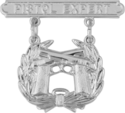 |
||
| Badge | Navy/Marine Corps Parachutist Insignia | |||||||||||||||
|---|---|---|---|---|---|---|---|---|---|---|---|---|---|---|---|---|
| 1st row | Navy Cross | Navy Distinguished Service Medal | ||||||||||||||
| 2nd row | Legion of Merit with 2 award stars & valor device | Bronze Star Medal with "V" device | Purple Heart | Air Medal | ||||||||||||
| 3rd row | Navy Presidential Unit Citation with 3 service stars | China Service Medal with 1 service star | American Defense Service Medal with Base clasp | American Campaign Medal | ||||||||||||
| 4th row | Asiatic-Pacific Campaign Medal with 3 service stars | World War II Victory Medal | Navy Occupation Service Medal | National Defense Service Medal with 1 service star | ||||||||||||
| 5th row | Korean Service Medal with 4 service stars | Vietnam Service Medal with service star | Order of Service Merit, Second Class | National Order of Vietnam, Commander | ||||||||||||
| 6th row | Vietnam Gallantry Cross with palm | Korean Presidential Unit Citation | United Nations Korea Medal | Vietnam Campaign Medal | ||||||||||||
| Badge | Rifle Expert Marksmanship Badge | Pistol Expert Marksmanship Badge | ||||||||||||||
Supporting New Military Vehicles
Krulak was an early supporter of using helicopters to carry soldiers into battle. He also played a key role in developing the Higgins boats, which were vital for landing troops and supplies during World War II.
Life After the Military
After retiring from the Marine Corps, Krulak worked for Copley Newspapers. He was president of Copley News Service and vice president of Copley Press. He retired in 1977 but continued to write for them. Krulak also wrote several books, including his famous Marine Corps history, First to Fight.
He was a personal friend of President Ronald Reagan, and they often wrote letters to each other.
In his retirement, Krulak was active in his community. He was also involved in Marine Corps activities. He served as president of the Zoological Society of San Diego.
Victor Krulak passed away on December 29, 2008, at the age of 95 in San Diego, California. He was survived by his three sons: General Charles Krulak (a retired Marine Corps Commandant), Reverend Victor Krulak (a Navy Chaplain), and Reverend William Krulak (a Marine Corps Reserve Colonel). He also had four grandchildren and ten great-grandchildren. His funeral was held on January 8, 2009, and he was buried at Fort Rosecrans National Cemetery.
Honors and Legacy
In 2004, Lieutenant General Krulak received the U.S. Naval Academy's Distinguished Graduate award. This award honors alumni who have served the nation and made important contributions.
In 2007, Secretary of Defense Robert Gates spoke about Krulak's amazing career. He mentioned Krulak's Navy Cross, his work as an advisor, and his command during the Vietnam War. Gates said Krulak's story teaches us to learn from the past and be open to new ideas.
His book First to Fight won the 1984 Samuel Eliot Morison Award for Naval Literature.
The Brute Krulak Center for Innovation and Creativity (BKCIC) at the Marine Corps University is named in honor of Victor Krulak.
Images for kids


